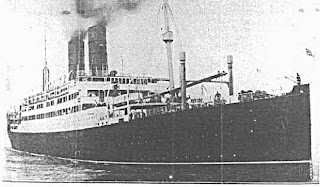Who was Homer G. Harris?
The call to arms prompted by the entry of the United States into World War I was answered by many young men in the nation. In the community of Thurber, Texas, Homer G. Harris was one such young man. Homer was born January 3, 1896, in Bell County, Texas, to Leonidas Signor Harris and Nancy Elizabeth Harris and was reportedly killed in action on June 2, 1918, in the fighting around Chateau-Thierry during the famous Belleau Wood offensive in France. He was the youngest son among five brothers and sisters and one of three children born in Texas.
The United States Census of 1910 reported Homer’s father worked as a teamster and his two older brothers were employed in the mines in and around Thurber. Homer’s draft registration card from June 5, 1917, revealed that he joined his brothers in the mines prior to entering the military. Contemporary newspaper accounts note that Homer was the first man from Thurber to fall in the Great War. Homer’s family was rather well-known in the community and his death was mourned by many Thurber residents.
 The Tuscania as it looked at its launching in February 7, 1915
The Tuscania as it looked at its launching in February 7, 1915 Homer G. Harris completed military basic training in late 1917 and was immediately shipped to New York, then to Europe aboard the American troopship Tuscania. His first brush with death came on February 5, 1918. On that fateful day, a German U-Boat (submarine) torpedoed the Tuscania in the Irish Sea en route to Liverpool, England, with 2,179 American soldiers. Homer G. Harris was among the 1,832 survivors reported in the February 11, 1918, edition of the Dallas Morning News. Tuscania was the first ship carrying American troops to be sunk and the populace was outraged. In 1920 a monument was erected by the American Red Cross on the Isle of Islay where many of the victims were buried before their transfer that year to the American War Cemetery at Brookwood, England, or back to the United States.
 The Tuscania Disaster sparked outrage among the American people, as it was the first time a ship carrying American soldiers had been sunk by enemy forces Private Harris was originally deployed to Europe along with the 32nd “Red Arrow” Infantry Division, a National Guard unit with volunteers primarily from Michigan and Wisconsin, because he had trained with them at Camp Bowie in Ft. Worth, Texas, and was with them aboard the Tuscania. After his rescue, however, Private Harris was transferred to the U.S. Army’s 9th Infantry Regiment of the 2nd “Indian Head” Division and sent to the front lines at the Belleau Wood sector. When the first elements of Homer’s division arrived in April of 1917, the embattled armies there had been locked in a stalemate for four years. They moved to Chateau-Thierry where they combined with U. S. Marines to conduct a long series of daring and reckless night raids and skirmishes into the German lines around Belval Forest.
The Tuscania Disaster sparked outrage among the American people, as it was the first time a ship carrying American soldiers had been sunk by enemy forces Private Harris was originally deployed to Europe along with the 32nd “Red Arrow” Infantry Division, a National Guard unit with volunteers primarily from Michigan and Wisconsin, because he had trained with them at Camp Bowie in Ft. Worth, Texas, and was with them aboard the Tuscania. After his rescue, however, Private Harris was transferred to the U.S. Army’s 9th Infantry Regiment of the 2nd “Indian Head” Division and sent to the front lines at the Belleau Wood sector. When the first elements of Homer’s division arrived in April of 1917, the embattled armies there had been locked in a stalemate for four years. They moved to Chateau-Thierry where they combined with U. S. Marines to conduct a long series of daring and reckless night raids and skirmishes into the German lines around Belval Forest.By November 5, 1918, they finally broke the stalemate and halted the German advance on Paris which resulted in the signing of the armistice on November 11, 1918. Unfortunately Homer G. Harris was not allowed to bask in the glory of his unit’s victory because he was killed in the fighting around Chateau-Thierry on June 2, 1918.
The U.S. Army’s official casualty report from June 21, 1918, states that Private Harris was killed in action like many other brave, young American soldiers in one of the bloodiest battles in American military history. As with many World War I casualties, most likely he was interred on the battlefield in France. Later his body was exhumed and shipped home for burial at the end of the American occupation of Germany after the signing of the armistice. His body arrived by train at the railway station at Mingus and was buried with full military honors in the Thurber Cemetery on September 8, 1921, according to a story in the Fort Worth Star-Telegram the following day. The paper reported that a procession almost two miles long accompanied his remains from the railhead in Mingus to the Harris family home in Thurber.
 Homer G. Harris’s Grave at its current location in Mount Marion Cemetery in Strawn, Texas
Homer G. Harris’s Grave at its current location in Mount Marion Cemetery in Strawn, Texas
Because Homer was the first Thurber native to fall in World War I, local veterans named the Homer G. Harris American Legion Post No. 14 in his honor. During the time after Homer G. Harris’s burial, the post was an important community organization and held many popular social events, most notably the Water Carnival at Thurber Lake (Big Lake) on July 22, 1922, boxing bouts, and Armistice Day dances and athletic contests, such as football and baseball games. The post was disbanded about 1933 when the Texas & Pacific Coal & Oil Company closed the town of Thurber and moved their offices to Fort Worth.

